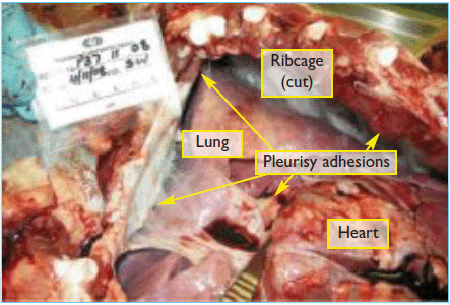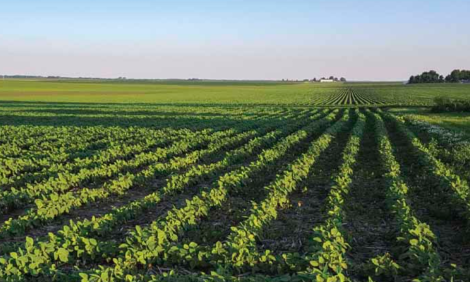



Pleurisy
Production losses from pleurisy can typically be as high as £3.72 per pig, according to BPEX in its updated 'Action for Productivity' series, no. 28. The costs to the producer and the processor are outlined, together with advice on how to minimise these losses.Many infectious organisms can be involved in causing pleurisy, including PRRSV, APP and PCV2. During infection, the pleura (the lining that surrounds the lungs and the chest cavity) become inflamed and rub together, potentially causing pain when breathing.
Cost of Pleurisy to the Producer
BPEX-funded research by a group led by the University of
Cambridge found that pleurisy is associated with a lower
average lifetime daily weight gain, a lower carcass weight
(costed at £1.50 per kg) and an older than average slaughter age
(costed as feed at 52p per pig per day). Herds with pleurisy
prevalence running at 10 per cent or more at slaughter also have post-weaning
mortality rates around 3.3 per cent higher than unaffected units.
In a batch of pigs, every one per cent increase in the number of pigs
with pleurisy reduces average trimmed carcass weight by 70g
and increases the average days to slaughter by 0.26 days.
This means for a batch of 100 pigs in which 10 pigs had signs
of pleurisy, the cost in terms of increased post-weaning
mortality reduced carcass weight and increased age at
slaughter, is as follows:
| Impact | Cost/100 pigs | |
|---|---|---|
| Increased post-weaning mortality | 3.3% increase @ £40/pig | £132 |
| Reduced carcass weight | 700g/pig @ 150p/kg = 70kg | £105 |
| Increased days to slaughter | 2.6 days/pig with feed @ £215/tonne = 260 days | £135 |
| Total | £372 |
Cost of Pleurisy to the Abattoir
Pleurisy results in extra processing costs at the abattoir
because of the extra trimming required to separate the lungs
from the carcass wall and increased costs of disposal.
For a batch of 100 pigs where 10 per cent (10 pigs) have severe
pleurisy, an estimate of the cost in terms of extra trimming
and disposal of condemned material based on records from
a batch of 1,191 pigs is as follows:
| Impact (batch of 1,191 pigs) | Cost/100 pigs | |
|---|---|---|
| Overtime for entire slaughter | 8.5% reduction in line speed (+25 min) = £199/batch | £16.70 |
| Additional staff required | 1 additional slaughter man = £35/batch | £2.95 |
| Overtime for MHS | £106/batch | £8.90 |
| Increased costs of disposal for Category 2 animal by product | £14/batch | £1.20 |
| Total | £354/batch | £29.75 |
To compensate for these additional costs, some processors automatically deduct weight from the carcass if severe pleurisy is evident; the weight deducted can be as much as 0.5kg.

Management Guidelines
- Buy stock from an appropriate source, depending on your herd health status
- Isolate incoming pigs for six to eight weeks and check source health status with your supplier before integrating pigs into your herd
- Optimise stocking levels and ventilation in your buildings
- If not already managing buildings all-in all-out, try to see if you can change your system to make this possible
- Make sure you have a thorough cleaning, drying and disinfection programme in place (see Action for Productivity 10: C&D)
- Review your control programmes for PCV2 and PRRS; even subclinical infections with these viruses appear to be important
- In heavily infected herds where the causal organism(s) has been identified, it may be necessary to consider a partial or complete depopulation-repopulation strategy. Discuss this with your veterinary surgeon to check whether it is likely to be effective, given the health status on your farm.
No one approach will apply to all farms. Management of the
environment and stress will depend on the design of the
piggery and the facilities available and may affect the success
of any programme based on vaccination or the strategic use
of antibiotics.
Work with your vet to develop a management plan that is
appropriate for your farm. Give changes time to work and
keep checking if there is an effect on your pleurisy scores in
BPHS and on partial and total condemnations.
Factors associated with reduced levels of pleurisy in pigs at herd level
- Cleaning, drying and disinfecting finisher pens before refilling
- Minimising contact between pigs of different age groups
- More down-time for grower pens before refilling to ensure sufficient drying time
- No mixing of pigs
- Minimal moving of pigs around the unit
BPHS Reports
- The BPHS report provides a pleurisy score for every batch of pigs assessed. The severity of pleurisy is determined by the proportion of the lung that is affected
- Any small area of pleurisy, regardless of whether it is on the lung or attached to the chest wall, is classed as localised (score 1)
- Larger areas of pleurisy, over about one-fifth of the total lung area, are classed as extensive (score 2)
- Add the scores for localised and extensive to find the total percentage of pigs that had pleurisy in the batch assessed
- A guide to interpreting BPHS producer report sheets can be downloaded from www.bpex.org.uk
BPHS interpretation chart
The bar chart on the report also shows the number of individual pigs with pleurisy that occur:
- together with pericarditis (inflammation of the lining that covers the heart)
- with enzootic pneumonia (EP)-like lesions
- in isolation.
Your veterinary surgeon will be able to help you use these results to determine the likely cause of pleurisy within the herd.
What were your recent BPHS pleurisy scores? Can you see a trend? Discuss these with your veterinary surgeon and ensure that an appropriate strategy is in place to maintain or control the status of your herd(s).
Further ReadingGo to our previous news item on this story by clicking here.Find out more information on the diseases mentioned in this article by clicking here. |
April 2013








